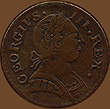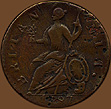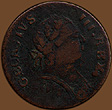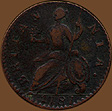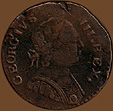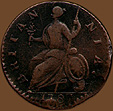Machin's Mills Imitation British Halfpence
obverse |
|
reverse |
| |||
1787 Vlack 18-87C Machin Mills Imitation Halfpenny
Obverse: GEORGIVS. III. REX.
Reverse: BRITAN NIA.
Weight: 117.2 g (7.62 grams) Diameter: 27.6 mm
Comments: The dies for this coin are attributed of James Atlee while he was in residence at Machin's Mills. This obverse can be distinguished by the letter R which had a very long ending stroke, in REX the R touches the E. Also, the stop after GEORGIVS is near the center of the S but the other two stops are low. The bust is characterized as a round head with puckered lips and almond shaped eyes. There are several small die cracks - as at the shoulder under the G, just to the bottom left of the vertical stroke on the E, at inside of the bow on top of the second G, on the first stroke of the V and a dot in the bottom bow of the S. This obverse was only jointed with reverse 87C (1787).
The reverse die can be distinguished in that branch arm points between the T and the A. There is a single exergue line with a large date below. On the date the 17 are close together and to the left. The bottom of Britannia's pole points just to the right of the first 7. The 8 leans to the right and the final 7 is higher and larger. This example has some small voids on the right edge and at the date. The 87C reverse was used with George III obverses 18-21 and 23 and was also joined with a Vermont obverse (Bressett 17; [RR 13] also listed as Vlack 24). The Vermont coins show a very late state of this die with most of the legend and date, having been worn off the die. See the example of this reverse with obverse 19 (below) and with the Vermont obverse Bressett 17 (in the Vermont coppers section).
Provenance: From the Robert H. Gore, Jr. Numismatic Collection.
obverse |
|
reverse |
| |||
1787 Vlack 19-87C Machin Mills Imitation Halfpenny
Obverse: GEORGIVS III . REX .
Reverse: BRITAN NIA . 1787
Weight: 110.2 g (7.14 grams) Diameter: 28.2 mm
Comments: The dies for this coin are attributed of James Atlee while he was in residence at Machin's Mills. A second example follows. The obverse die can be distinguished by several features. It is one of the few dies without a stop after GEORGIVS, also note there is a die break connecting V with the end of the S. In the roman numeral III the third I is higher and the final stop after REX is low and very large. The bust is characterized by Peters as a "round, fat face with puckered lips and almond-shaped eyes." This obverse was only combined with reverse 87C (1787).
The reverse die can be distinguished in that branch arm points between the T and the A. There is a exergue line with a large date below. On the date the 17 are close together and to the left. The bottom of Britannia's pole points just to the right of the first 7. The 8 leans to the right and the final 7 is higher and larger. This reverse was used with George III obverses 18-21 and 23 and was also joined with a Vermont obverse (Bressett 17 [RR 13] also listed as Vlack 24). The Vermont coins show a very late state of this die with most of the legend and date, having been worn off the die. See the examples of this reverse with obverse 18 (above) and with the Vermont obverse Bressett 17 (in the Vermont section).
Provenance: Donated to Notre Dame in 1887 as part of a 2,300 item coin collection (see: The Notre Dame Scholastic, vol. 21 (September 1887) 45.
obverse |
|
reverse |
| |||
1787 Vlack 19-87C Machin Mills Imitation Halfpenny
Obverse: GEORGIVS III . REX .
Reverse: BRITAN NIA . 1787
Weight: 110.5 g (7.16 grams) Diameter: 28.7 mm
Comments: The dies for this coin are attributed of James Atlee while he was in residence at Machin's Mills. This is the same variety as the preceding coin. It is on a somewhat larger planchet with a few voids on the obverse. There appears to be a die break just to the right and above the second G in GEORGIVS. The obverse die can be distinguished by several features. It is one of the few dies without a stop after GEORGIVS, also note there is a die break connecting V with the end of the S. In the roman numeral III the third I is higher and the final stop after REX is low and very large. The bust is characterized by Peters as a "round, fat face with puckered lips and almond-shaped eyes." This obverse was only combined with reverse 87C (1787).
The reverse die can be distinguished in that branch arm points between the T and the A. There is a exergue line with a large date below. On the date the 17 are close together and to the left. The bottom of Britannia's pole points just to the right of the first 7. The 8 leans to the right and the final 7 is higher and larger. The 87C reverse was used with George III obverses 18-21 and 23 and was also joined with a Vermont obverse (Bressett 17; [RR 13] also listed as Vlack 24). The Vermont coins show a very late state of this die with most of the legend and date, having been worn off the die. See the examples of this reverse with obverse 18 (above) and with the Vermont obverse Bressett 17 (in the Vermont section).
Provenance: Donated to Notre Dame in 1887 as part of a 2,300 item coin collection (see: The Notre Dame Scholastic, vol. 21 (September 1887) 45.
| NYC Imitation Halfpence | Section Contents | Unattributed Imitation British Halfpence |
|
For viewing tips and information on optimal computer settings click
here.
For questions or comments contact Special Collections by: |
